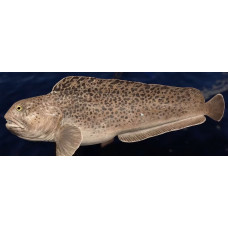Latin name
Anarhichas minor
Other names
Spotted sea cat, leopardfish.
Identification
The body is moderately elongated. The head is large. Coulter row of teeth does not protrude backward beyond the palatine rows. The lateral line is conspicuously absent. The tubercle-shaped teeth of this fish are less developed than in Atlantic wolffish.
Features of fish fins
The caudal fin is truncated and not fused with the dorsal and anal fins.
Fish colouring
The body is yellowish or greenish-brown with many rounded dark spots of varying sizes on the back and sides. Juveniles of this species have broad black transverse stripes on the body. As the juveniles transition to life on the bottom, the stripes break up into individual spots; these spots are well separated from each other and are not as clearly grouped into stripes as in the Atlantic wolffish.
Distribution
The range is roughly the same as that of the Atlantic wolffish, but it is less common in the southern parts of its range and more common in the northern parts. Off the coast of Norway it is only found north of Bergen, in the North Sea it is extremely rare and in the Baltic Sea it is absent. Around Iceland, one spotted catfish is caught for every 20 Atlantic wolffish. Along the Atlantic coast of North America, the spotted wolffish is extremely rare as far north as Massachusetts Bay, but it is found along the west coast of Greenland as far north as Thule.
Habitat
Like other catfish, the spotted wolffish inhabits the mainland slope. It stays at deeper depths than the Atlantic wolffish (up to 550m) and avoids thickets of seaweed. It goes deeper in winter than in summer. Prefers silty-sandy soils.
Size
The maximum length is 180 cm and the mass is 27.9 kg.
Behavior
Does not like to live in large herds, migrates rarely and not over long distances. Movements are generally less than 100 km. There are longer migrations, but these are all related to spawning. Life span is 21 years.
Food and feeding habits
The diet is similar to that of the Atlantic wolffish, but with more echinoderms (brittle stars, starfish and sea urchins) and fewer molluscs.
Reproduction
The breeding season is in summer. In a clutch of 12-50 thousand eggs (at a fish length of 87-120 cm). The eggs are similar in size to those of the striped catfish and are similarly grouped in clutches, but these clutches are found at greater depths (more than 100 m) than those of the Atlantic wolffish. The young are pelagic.
Fishing
Its meat is said to be no less tasty than that of the Atlantic wolffish. The skin of the spotted catfish has long been used as a material for various products - toppers for light shoes, handbags, book bindings and so on.
| Classification | |
| Phylum | Chordata |
| Class | Actinopterygii |
| Squad | Scorpaeniformes |
| Family | Anarhichadidae |
| Genus | Anarhichas |
| Species | A. minor |
| Features | |
| Conservation status | Near Threatened |
| Habitat | Pelagic |
| Life span, years | 21 |
| Maximum body weight, kg | 27,9 |
| Maximum length, cm | 180 |
| Sailing speed, m/s | No information |
| Threat to people | Edible |
| Way of eating | Predator |
Spotted wolffish
Tags: spotted wolffish

